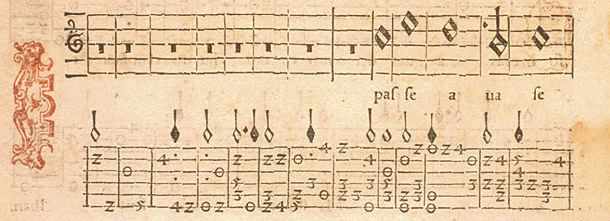Diego Pisador
Paseábase el rey moro
Libro de música para vihuela (1552), fol. 5v
pi009
| Source title | Passeavase el rey moro a quatro las tres tañidas y la otra cantada entonase la primera en segundo traste. |
|---|---|
| Title in contents | Roma[n]ce, passavuase el rey Moro, las tres bozes tañidas y la otra se ca{n]ta por defuera. |
| Text incipit |

Music
Category intabulation
Genre romance
Fantasia type
Mode 3 or 4
Voices 4
Length (compases) 46
Vihuela
Tuning G
Courses 6
Final IV/4
Highest I/7
Lowest VI/0
Difficulty not specified
Tempo not specified
Song Text
Language ES
Vocal notation texted staff notation
Commentary
A vihuela arrangement of what was probably a four-part polyphoniic setting of the romance ¡Ay de mi Alhama! -- no. 1485 in the Petersen Romance database https://depts.washington.edu/hisprom/ballads-new/bdgpidaction.php (accessed 12 Jan 2023). Pisador’s rubric explains the use of a mensural staff together with the vihuela tablatrure, arranged in score, saying “in four voices: three voices played and the other sung, tuning the first [sung note] on the first course, at the second fret”, thus indicating tuning in G. Other settings with same text and closely related melodies, but in different settings. See Narvaez (na025), Fuenllana (fu167). See also angles1944 (p. 153) for a version with different music and without text.
The text deals with the reconquest of Alhama on 28 February 1482 under the command of Don Rodrigo Ponce de León, duke of Cadiz, and incident that sparked the last war of Granada. It’s unusual feature is the refrain sung at the end of each stanza. (pisador2002, I, 72)
The extended text given below, beyond that given by Pisador is from Binkley Spanish Romances (with English translation), 108.

Editions
Literature
Recordings
Song Text
Passeávase el rey moro
por la ciudad de Granada,
quando le vinieron nuevas
que Alhama era ganada.
¡ay, mi Alhama!
[Las cartas echó en el fuego
y al mensajero matara,
echó mano a sus cabellos
y las sus barbas mesaba.
¡Ay, mi Alhama! […]
-Para que sepáis, amigos
la gran pérdida de Alhama.
-Bien se te emplea, señor,
señor, bien se te empleaba
¡Ay, mi Alhama!
Por matar los bencerrajes,
que eran la flor de Granada,
acogiste a los judíos
de Córdoba la nombrada
¡Ay, mi Alhama! […]
-Ay, si os pluguiese, mis moros,
que fuésemos a cobralla.
-Mas si, rey, a Alhama has de ir,
deja buen a cobro Granada.
¡Ay, mi Alhama! […]
Combatenla prestamente,
ella está bien defensada,
de que el rey no pudo más
volvió muy triste a Granada.
¡Ay, mi Alhama!]
The morísh king was out walking
in the city of Granada
letters delivered to him
Telling how Alhama was taken.
¡Ah, my Alhama!....
He threw the letters into the fire
and killed the messenger,
he took hold of his hair
and stroked his beard.
So that you may know, my friends,
the great loss of Alhama
-You were well employed, sir,
sir, you were well employed!
For killing the Abencerrajes,
who were the flower of Granada,
you took in the Jews
of Cordoba, the so-called.
If it would please you, my Moors,
if we were to go and collect the money,
but if, King, you have to go to Alhama,
leave Granada to collect the money,
Fight it quickly,
it is well defended,
since the king could no longer
return very sadly to Granada.
Alas, my Alhama].